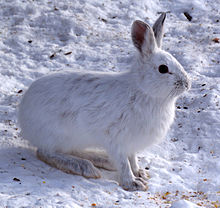
Back قواع ثلجي النعال Arabic ارنب حذاء الثلوج البرى ARZ Libakol (Lepus americanus) AVK Amerika ağ dovşanı Azerbaijani Американски заек беляк Bulgarian Gad Amerika Breton Llebre americana Catalan Lepus americanus CEB Zajíc měnivý Czech Sneskohare Danish
| Snowshoe hare[1] | |
|---|---|

| |
| Summer coat, photographed in Olympic National Park, Washington | |

| |
| Winter coat, photographed near Shirleys Bay, Ontario | |
| Scientific classification | |
| Domain: | Eukaryota |
| Kingdom: | Animalia |
| Phylum: | Chordata |
| Class: | Mammalia |
| Order: | Lagomorpha |
| Family: | Leporidae |
| Genus: | Lepus |
| Species: | L. americanus
|
| Binomial name | |
| Lepus americanus Erxleben, 1777
| |

| |
| Snowshoe hare range | |
The snowshoe hare (Lepus americanus), also called the varying hare or snowshoe rabbit, is a species of hare found in North America. It has the name "snowshoe" because of the large size of its hind feet. The animal's feet prevent it from sinking into the snow when it hops and walks. Its feet also have fur on the soles to protect it from freezing temperatures.
For camouflage, its fur turns white during the winter and rusty brown during the summer. Its flanks are white year-round. The snowshoe hare is also distinguishable by the black tufts of fur on the edge of its ears. Its ears are shorter than those of most other hares.
In summer, it feeds on plants such as grass, ferns, and leaves; in winter, it eats twigs, the bark from trees, and plants and, similar to the Arctic hare, has been known to occasionally eat dead animals.[3] It can sometimes be seen feeding in small groups. This animal is mainly active at night and does not hibernate. The snowshoe hare may have up to four litters in a year, which average three to eight young. Males compete for females, and females may breed with several males.
A major predator of the snowshoe hare is the Canada lynx. Historical records of animals caught by fur hunters over hundreds of years show the lynx and hare numbers rising and falling in a cycle, which has made the hare known to biology students worldwide as a case study of the relationship between numbers of predators and their prey.[4][5][6]
- ^ Hoffman, R.S.; Smith, A.T. (2005). "Order Lagomorpha". In Wilson, D.E.; Reeder, D.M (eds.). Mammal Species of the World: A Taxonomic and Geographic Reference (3rd ed.). Johns Hopkins University Press. p. 195. ISBN 978-0-8018-8221-0. OCLC 62265494.
- ^ Mills, L.; Smith, A.T. (2019). "Lepus americanus". IUCN Red List of Threatened Species. 2019: e.T41273A45185466. doi:10.2305/IUCN.UK.2019-1.RLTS.T41273A45185466.en. Retrieved 12 November 2021.
- ^ "Snowshoe Hare". eNature: FieldGuides. 2007. Retrieved 23 March 2008.
- ^ Krebs, C. J.; Boonstra, R.; Boutin, S.; Sinclair, A. R. (2001). "What Drives the 10-year Cycle of Snowshoe Hares?" (PDF). AIBS Bulletin. 51 (1): 25–35.
- ^ Krebs, Charles & Myers, Judy (12 July 2014). "The Snowshoe Hare 10-year Cycle – A Cautionary Tale". Ecological Rants. University of British Columbia. Retrieved 7 October 2015.
- ^ "Predators and their prey". BBC Bitesize. BBC. Retrieved 7 October 2015.
